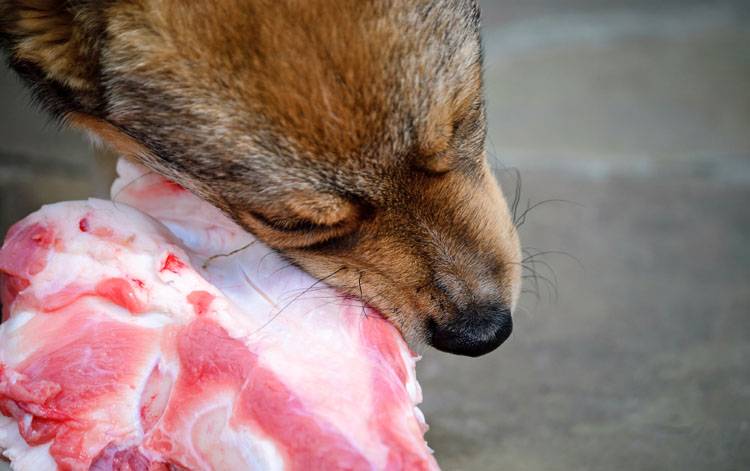Raw Dog Food Diets Don’t Always Work
OK, this is hard to admit as I’m a die-hard raw dog feeder, but not all dogs can eat raw dog food. Yes, it’s true. I’ve lived the struggle and want to share my story. Understand, I believe a raw or cooked diet is best for most dogs, but not all dogs.
Story That Changed My View
Looking outside the box of processed kibble, I began feeding my dogs a raw diet about 15 years ago. Most dogs thrive on a raw dog food diet, but over the years I noticed Kira, my fawn Bouvier, and Sobek, my Rottweiler, didn’t do so well. Both lost weight within a week of eating only raw dog food. They didn’t just lose a few pounds; they lost 10-15 pounds on average. Folks, that’s not normal.
Both dogs were restless. They had a very difficult time settling down. After a raw meal, both would pace back and forth while panting, which would last for hours. Sobek whined relentlessly while moving back and forth from a play bow to stretching out his back legs. This boy was in pain.
Plus, on raw dog food, both my dogs had dry flaky skin and a sour mildew odor present at all times. Oddly, their fur felt like straw. It was stiff and dry, and it felt like a pig’s coarse coat. They developed hot spots every couple of months and had smelly ears and horrible breath, but had spotless teeth from eating raw meaty bones. I knew a raw food diet wasn’t working. I had to fix it.
Allow me to explain that Kira passed away in 2010 and Sobek was born in 2012, so they never knew each other. However, they both exhibited the same symptoms. I know each dog is sent to teach me something new, but I guess I needed another reminder to stop being a dog food snob again.
Switching to Kibble, Oh My
Personally, I believe some dogs just aren’t able to digest a raw food diet. Both dogs didn’t thrive on cooked foods either. I tried everything. Again, before raw dog food enthusiasts start listing things I should’ve done instead, allow me to explain further. This is not my first rodeo.
Both dogs were fed ample amounts of raw green tripe, digestive enzymes (over 10 different brands), probiotics made for dogs and store-bought raw meat. They followed a balanced diet per Monica Segal, consulted with multiple holistic vets and followed Traditional Chinese Medicine (TCM) food recommendations for balance. And yes, I tried the all-prey diet and so forth; nothing worked. I tried feeding different raw and cooked diets for years; it just didn’t work for them.
Once I put both dogs on kibble–and, interestingly, it was always a very specific brand–they flourished. Their stool was normal within 24 hours of transitioning from raw to kibble, and they gained two to three pounds per week. Their body odor and sour breath were gone within 24 hours too. After a week, their coat became lush and soft to the touch, and both dogs were finally able to settle down.
Now, Kira lived to 14 years of age. We helped her “cross the rainbow bridge” due to poor quality of life brought on by canine cognitive dysfunction. During her last two years, she didn’t have any idea where she was and lost all control of her bowels. This was no way to live.
Don’t Be a Dog Food Snob
As an educated dog lover, I had to stop being a dog food snob. We’re bombarded with commercials and blogs basically telling us we’re terrible pet owners if we feed meat byproducts, corn, wheat or kibble to our dogs. This is simply not the truth. Stop listening to what others say, and start listening to what your dog is trying to say.
Interestingly enough, both dogs thrived on a very specific brand and recipe of kibble, which mortified me in the beginning. Then, I needed to suck it up and feed them what worked best for them and not me. Some dogs are able to spin kibble into gold, and we must honor that. It’s what works best for them.
Listen to your dog. He’ll guide you in the right direction.





